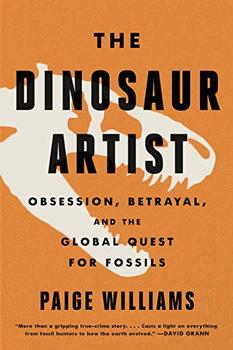Summary | Excerpt | Reviews | Beyond the Book | Readalikes | Genres & Themes | Author Bio

Obsession, Betrayal, and the Quest for Earth's Ultimate Trophy
by Paige Williams
A fossil's contextual information is as important as the fossil itself. Extracting a fossil minus that correlating data has been compared to removing a corpse from the scene of a homicide without noting, say, the presence of shell casings or biological evidence like semen and blood. Approximate cause and time of death may be inferred, but a fossil alone cannot tell the whole story; in fact, the whole story can never be told, at least not without a time machine. But the story starts to come together through the analysis of details like the circumstances of fossilization (called taphonomy), the presence of other fossil animals and plants, and stratigraphy, which helps paleontologists understand when the animal lived and died. The enormous femurs found protruding from the Big Bone Lick bogs of Kentucky (as happened in the 1700s) tell one story; the large three-toed footprints found sans bones in the Connecticut River Valley of Massachusetts (as happened in the 1800s) tell another.
For decades the federal government debated whether and how to regulate fossil collecting, particularly regarding vertebrates, which are less common than invertebrates. The most extreme-minded paleontologists have long wanted a ban on commercial collecting, but commercial hunters organized against the idea. They defended their trade, and paleontologists defended the objects fundamental to their science.
Despite experience and field expertise, dealers who call themselves "commercial paleontologists" are not in fact paleontologists. Paleontology would not exist without them, though. The science started at the hands of natural history lovers—started long before the words science and paleontology even existed—and became perhaps the only discipline with a commercial aspect that simultaneously infuriates scientists and claims a legitimate role in the pantheon of discovery. The work of commercial hunters has allowed paleontologists some of their biggest breakthroughs and museums their most stunning displays. Museum visitors may not realize they're often looking at specimens discovered not by scientists but rather by lay people like themselves. A California boy named Harley Garbani became obsessed with fossils in the 1930s, after finding part of a camel femur while following in the tracks of his father's plow. He became a plumber but went on to find extraordinary, tiny fossils by crawling on his hands and knees in "cheaters" (jewelers' goggles), plus the first significant Triceratops skeleton in over half a century and a T. rex skeleton so good it would take years for someone to come across a better one. By the time Garbani died, in 2011, he had collected for the Natural History Museum of Los Angeles County and the University of California–Berkeley's Museum of Paleontology. Lowell Dingus, an American Museum of Natural History (AMNH) paleontologist who knew Garbani while in grad school at Berkeley, called him "among the greatest fossil collectors that ever lived and the greatest one that I have ever known and worked with."
A more recent collector was Stan Sacrison, an electrician and plumber from Harding County, South Dakota, the self-declared "T. rex Capital of the World." In the 1980s and '90s, Sacrison found such notable rex specimens that with each new discovery his twin brother, Steve, a part-time gravedigger and equally gifted fossil hunter, carved notches into the handle of his Bobcat earthmover. Discovering even one or part of one T. rex was a feat, given that fewer than fifteen had been unearthed. The Sacrison twins, who lived in the tiny town of Buffalo, had grown up near fossil beds and were taken with the hunt. They had learned that it was smart to search after a big storm or a spring thaw because weather and erosion unwrap gifts of bone. They had familiarized themselves with geology, knowing it's as pointless to search for mastodon in rock formations 100 million years old as it is to look for Vulcanodon in sediments laid down during the Pleistocene.
Excerpted from The Dinosaur Artist by Paige Williams. Copyright © 2018 by Paige Williams. Excerpted by permission of Hachette Books. All rights reserved. No part of this excerpt may be reproduced or reprinted without permission in writing from the publisher.
Your guide toexceptional books
BookBrowse seeks out and recommends the best in contemporary fiction and nonfiction—books that not only engage and entertain but also deepen our understanding of ourselves and the world around us.